Patio materials: pros and cons of patio and deck materials
Make the smart choice when choosing patio materials for your perfect outdoor seating area


Design an outdoor space using the right patio materials and it will be a joy to use, be easy to maintain and make a true style statement too. More than creating a spot to sit and unwind, choosing the perfect surface will set the mood and overall look and feel of your outside space.
With so many different patio materials to choose from, it’s important to weigh up exactly what each can offer before you buy and consider how well they perform too. From uber-smart stone to Scandi-style decking and good old gravel, each brings its own unique tone, texture and charm to your plot, so think carefully about the impression you want to create.
Smooth, large format porcelain planks are a brilliant option for your patio ideas if you are after a seamless and contemporary extension to your inside space, whereas ‘look-at-me’ encaustic tiles instantly add bold personality and individual charm.
Of course, different materials demand varying amounts of upkeep too, so it pays to be realistic from the outset, about how much time you want to spend topping up gravel or scrubbing down deck boards.
Choose the right patio materials for your plot
Carefully assess the position of your patio and bear this in mind when choosing your patio materials. Constantly clearing fallen leaves off slate chippings is time consuming and never fun, while patio paving ideas like stone or cement tiles can be swept clear in seconds and always look super smart.
However there are always pros and cons to all patio materials. So it's important to think about your own specific needs before you start thinking about how to lay a patio.
1. Gravel
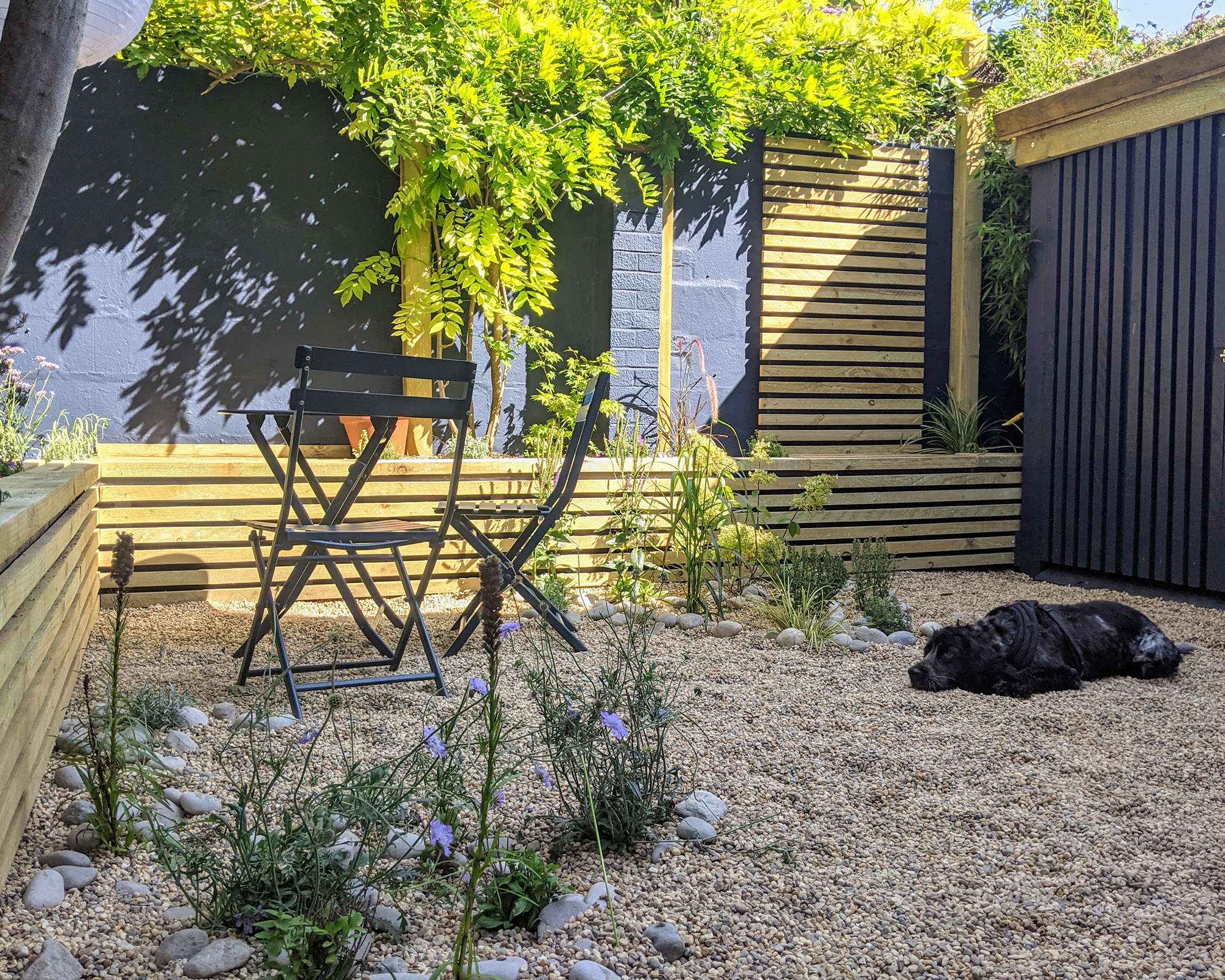
A mass of tiny stones, this product is often associated with grand sweeping drives and period properties but will work just as well for small patio ideas. Naturally formed and quarried, the material varies in color, texture and make-up and is often a mix of different stone types.
'Decorative gravel is easy to walk on and simple to maintain. It makes a great choice for patios, garden paths and planting areas or borders and is ideal for informal planting,' says the team at Decorative Aggregates.
Sticking to a larger grade of gravel for patio materials is a must, as this will help limit the material to one specific area, but there are other tricks to try. 'A gravel area will need a retaining edge in order to define it and prevent the stones escaping into other areas,' explains Jo Fenton, Partner at Fenton Roberts Garden Design. 'We often use granite setts but we also like flexible metal garden edging as it's versatile and very easy to install.'
Pros of using gravel:
- Satisfying crunch under foot
- Good deterrent for burglars as noisy to walk on
- Quick and easy to lay
- Good range of colors and sizes
- Great for awkward shaped areas
- Retains moisture, enables drainage and suppresses weeds
- Good value for money
Cons of using gravel:
- Smaller stones can travel onto lawns and inside the house
- Needs topping up yearly
- Worn areas can need raking regularly to redistribute
2. Stone chippings

More angular in shape, and often larger than gravel, stone chippings are handy for creating flatter textured surfaces that are comfortable underfoot. Sold in bulk and available in a wide range of natural and artificial colors, the pieces all come from the same source so have a more uniform and monochrome appearance.
Stone chippings will complement cool and contemporary garden furniture ideas too.
Pros of using stone chippings:
- Contemporary, yet textured finish
- Good for adding subtle color
- Easy and quick to lay
- Inexpensive for covering large areas
- Easy to reuse
- Retains moisture, enables drainage and suppresses weeds
Cons of using stone chippings:
- Weeds can grow amongst chippings
- Needs twice yearly topping up
- Requires a raised edge to contain it
- Uneven surface
3. Cobbles and pebble mosaic

Made by packing rounded stones tightly together and bedded in mortar, this option is great for adding texture and intricate designs. Landscaping ideas with rocks are perfect for expressing your creative talents, and although it can take time and careful planning it's a great way to bring unique charm to your plot.
Although fascinating to look at it does create an uneven surface which can be awkward for keeping smaller tables and chairs level. Instead use with larger, sturdy pieces of outdoor furniture or built-in seating. It also works best as a detail or a feature, as Terrey Maufe, Design Director at Outerspace Gardens explains. 'A mosaic pebble panel serves as a contrast in texture and color to adjoining surfaces. The pebbles themselves are obviously a natural stone product and in this situation are backed on a mesh to ensure they can be more easily laid and the joints are consistent.
'The pebbles are grouted following installation using an exterior product rather than traditional jointing compounds like sand and cement mortar, so joints are smooth, and the color complements the pebble material.'
The pros of using cobbles and pebble mosaic:
- Great for adding pattern and individuality
- Good for a rustic and informal look
- Natural charm and tones
- Easy to adapt for irregular shaped areas
The cons of using cobbles and pebble mosaic:
- Uneven surface for furniture and to walk on
- Time consuming to design and lay
- Tricky to clean
- Hard to rework
4. Bark mulch
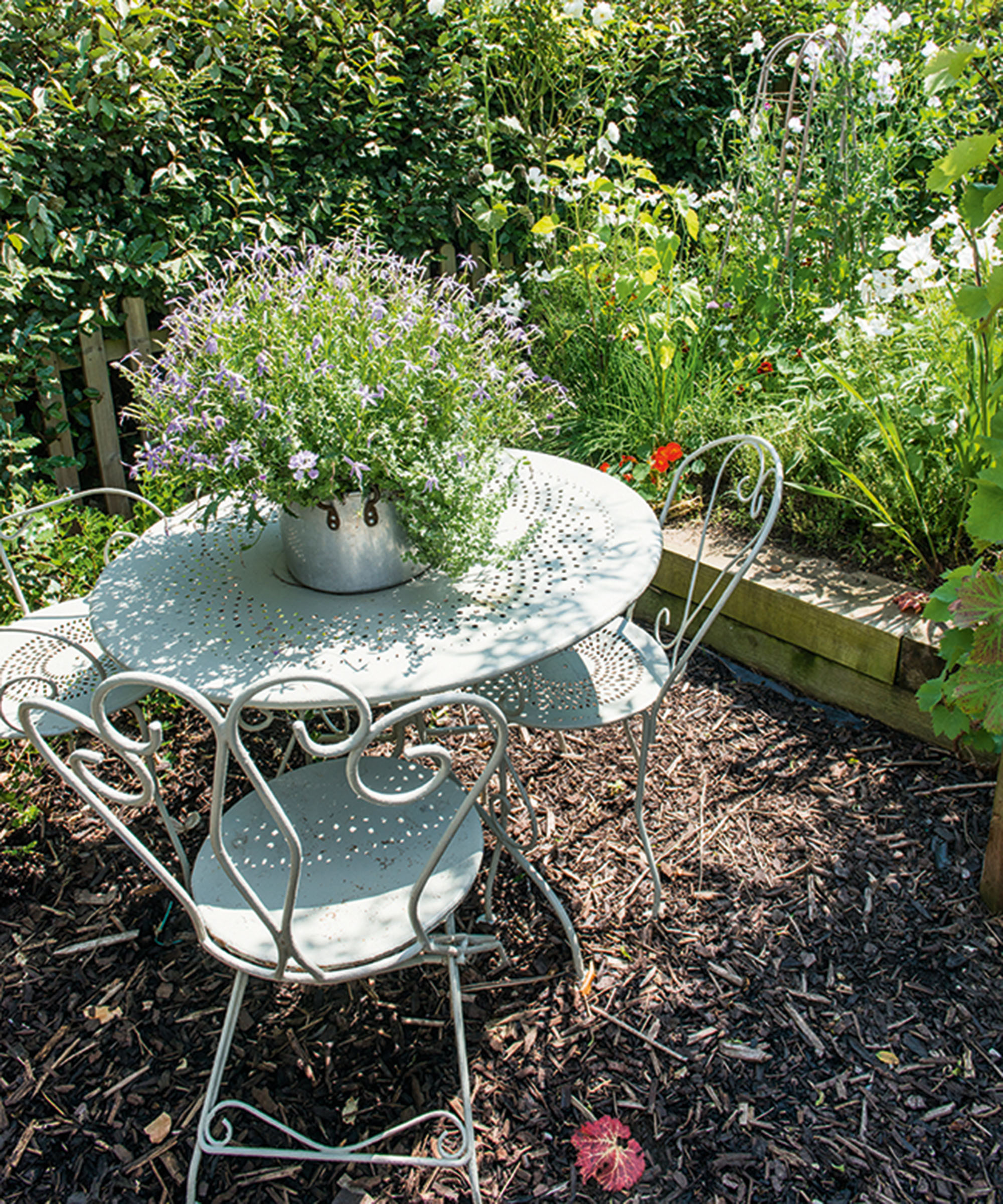
Often used as landscaping around trees and on borders to suppress weeds and retain moisture, bark chippings also make a practical patio surface. Yes, it looks very rustic and will need regularly raking and topping up, but it can prove an effective and environmentally friendly solution. And given the price in comparison to other patio materials it's a great budget patio idea.
Usually made from spruce or pine bark chopped into small slivers, this product is often a waste product of the timber industry. For best results, do cover the area with landscaping fabric before spreading out the bark. This prevents weeds from popping up and bark being trampled into the earth below.
Pros of using bark mulch:
- Good for a rustic and natural look
- Biodegradable
- Inexpenseive to lay and cover large areas
- Speedy coverage
- Easy to remove
- Natural and artificually colored chips available
- Child and play friendly
Cons of using bark mulch:
- Needs topping up regularly
- Can become muddy in wet weather
- Not suitable for a neat, formal finish
- Needs a retaining edge
- Can spread onto surrounding surfaces and indoors
5. Granite paving
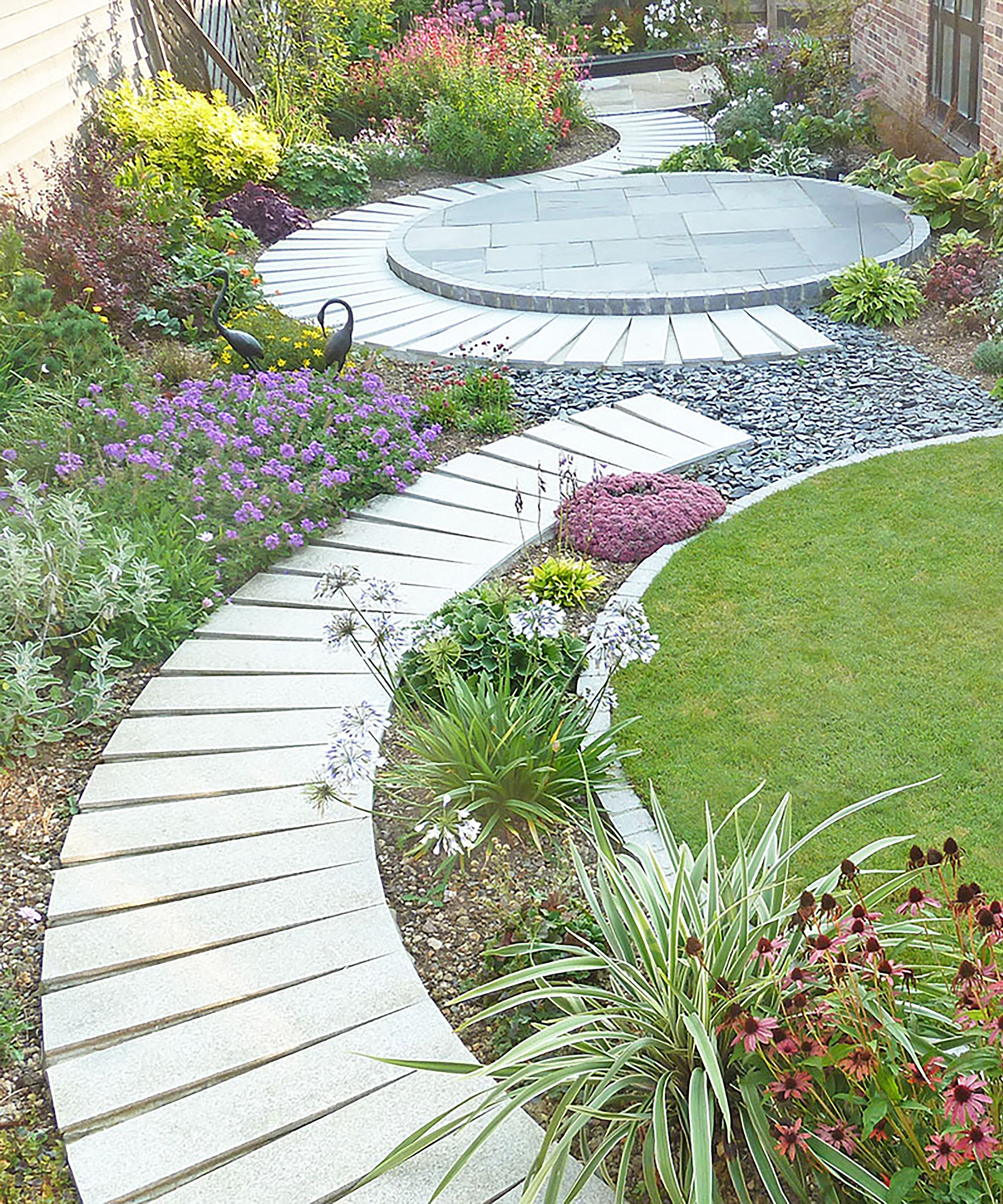
Typically silver-grey or dark-blue grey in tone, granite is one of the hardest patio materials available. But also one of the more expensive, so not great if you're looking for cheap garden ideas. Available as slabs or tiles it’s a great option for a bold, contemporary look. The speckled, slightly pitted surface is extremely durable, scratch and stain resistant. It also has great anti-slip properties, making it ideal for the UK climate.
The team at Nustone explain, 'Granite is one of the least porous types of natural stone, making it one of the easiest to maintain. When a stone takes on water, it can encourage the growth of algae and mould and also poses the risk of the water within the stone freezing and expanding within the winter months, causing cracks within the stone. Granite is less susceptible to this due to the reduced levels of porosity when compared to other types of natural stone.'
Pros of using granite paving:
- Extremely hardwearing
- Uniform in look and finish
- Natural coarse grain provides extra grip
- Dark mottled tones with a slight sparkle
- Can be pressure washed
Cons of using granite paving:
- Heavy to lift
- Tricky to cut
- Expensive
- May need anti algae treatment in shady areas
6. Limestone paving

Highly popular, thanks to its smooth grain and paler tones, limestone is a firm favorite with top garden designers. Like this scheme designed by John Davies Landscape its natural subtle sheen oozes elegance and luxe living. But it's important to note this tough material does need some TLC.
The team at Stonemarket suggest, 'With limestone we would recommend using a pressure washer once or twice a year to keep the stone looking its best. This usually ends up being done at the beginning of spring and at the end of summer/beginning of fall.'
Pros of limestone paving:
- Hardwearing
- Smooth, undulating surface
- Uniform tones and grain ideal for contemporary feel
- Pale tones reflect light into dark areas
- Surface has a natural lustre
- Relatively easy to cut
Cons of limestone paving:
- Can require sealing to preserve color
- May need anti algae treatment in shady areas
- Protect and clean with a neutral or mild alkaline-based cleaner
- Easy to stain unless sealed
7. Sandstone paving

The showman of the stone paving world, sandstone comes in a huge range of colors, with sweeping marks and whispy lines. From neutral cream and grey to rainbow gold, red and deep brown shades there are plenty of options to suit your garden color scheme. There’s also a fair choice of different finishes too, including riven or split sandstone where it is prised straight from the quarried block leaving an undulating textured surface.
A sawn finish (as pictured above) is where the stone is precisely cut and honed to create a smooth face with a slight sheen, whereas shot blasting leaves a pitted and worn surface, that is slightly rough and great for added slip resistance.
Pros of sandstone paving:
- Rich, warm tones with individual markings and grain
- Wide range of colors
- Smooth, undulating surface
- Affordable option
- Relatively easy to cut
Cons of sandstone paving:
- Can require sealing to preserve color
- May need anti algae treatment in shady areas
- Soft surface compared to other stones so can scratch and mark
8. Slate paving
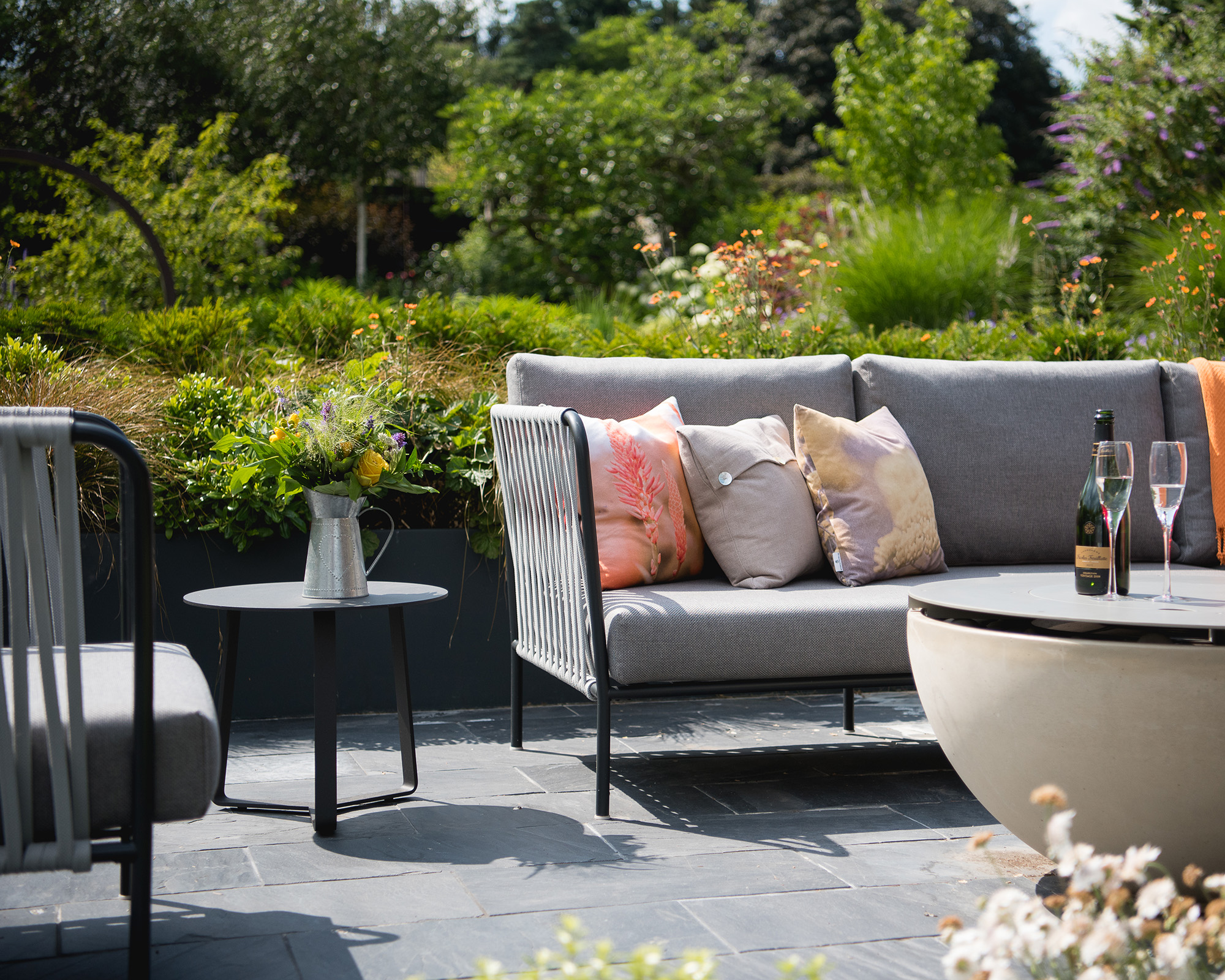
The layered composition of slate is unmistakable and gives even the sharpest patio design an inviting feel. Dark grey-blue shades are peppered with copper and bronze veining which gives this stone its unique and individual charm. Durable and affordable, it makes a bold contrast to most properties and mixed planting.
Designer Mandy Buckland from Greencube Landscapes is a firm fan of Brazilian Slate. 'The uniform color and surface texture of the Brazilian Slate lent itself perfectly to our schemes. The bold color of the stone creates an evenness across the terraced areas that complements a rich planting palette and contemporary garden furniture.'
Pros of slate paving:
- Dark, even color that suits modern designs
- Attractive yet uneven surface
- Stain resistant
- Doesn’t show dirt
- Natural anti slip surface
Cons of slate paving:
- Can be an expensive option
- Cheaper, less dense slate can scratch
- Tricky to cut due to lamination
- Pools of standing water can result in flaking
- May need sealing in very wet areas
9. Concrete or reconstituted stone paving
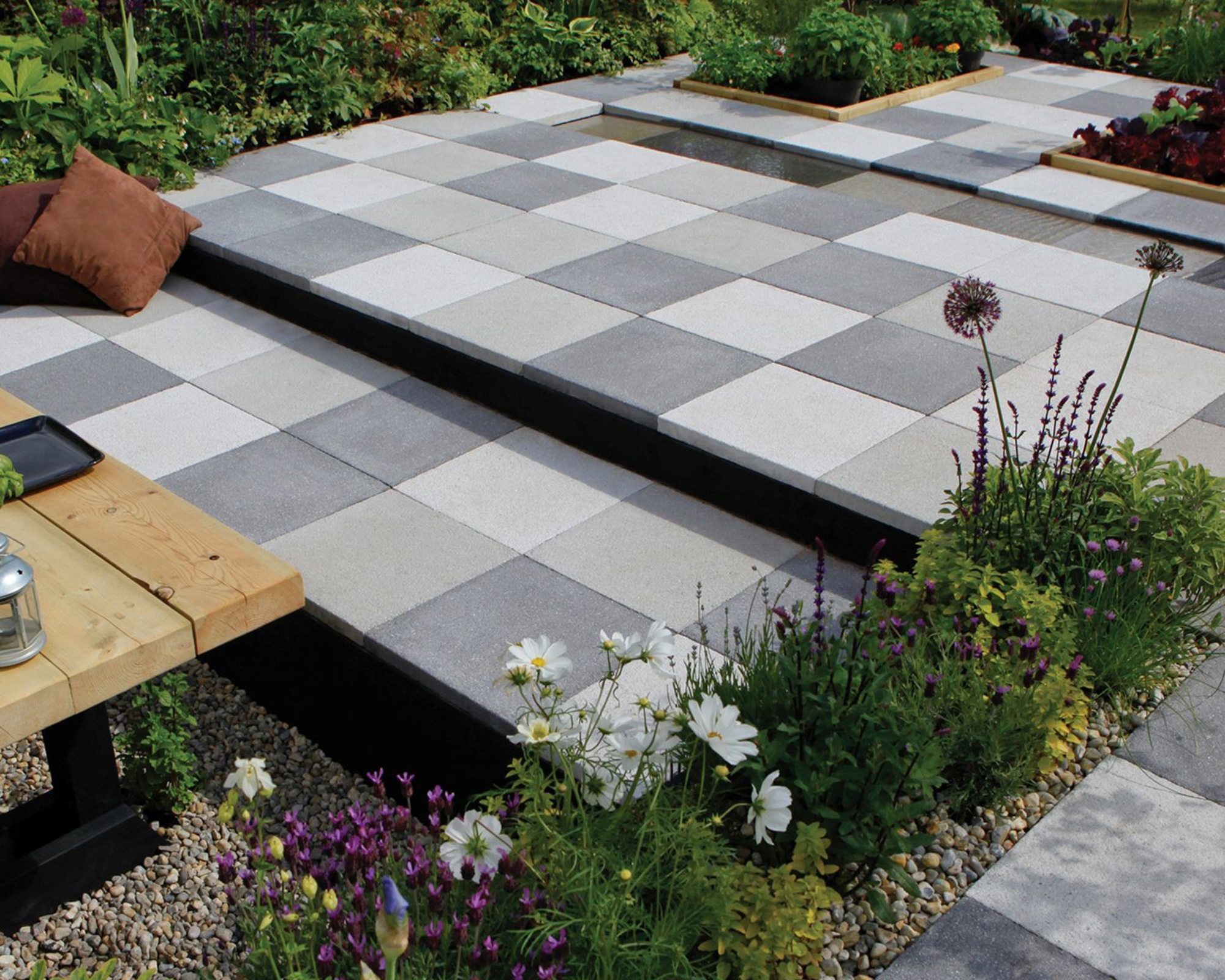
A man-made material that is a mix of stone, sand, water and cement, the latest products often include industry waste products, making them a sustainable option. There’s a wide variation in cost, looks and quality so do compare similar looking products before you buy the one you want for your concrete patio ideas. Expensive look-alike stone and timber concrete products can sometimes cost more than the real thing.
'Reconstituted stone paving is a man-made product that replicates the look and feel of natural stone,' says B&Q Category Manager Dawn Ritchie. 'This is also known as concrete, engineered stone, artificial stone or cast stone as it’s cast in specially made moulds. Reconstituted stone paving is often a popular option for outdoor gardens due to it being budget-friendly, low maintenance, durable and flexible so it’s a great option to overhaul your space without breaking the bank.'
Pros of concrete paving:
- Affordable
- Durable and hardwearing
- An endless range of colors and finishes
- Realistic stone look products
- Slip resistant
- Permeable paving available to aid drainage
- Consistent shapes and thickness for easy laying
Cons of concrete paving:
- Surface can wear over time
- Lifespan around 10-15 years
- Can lack natural variation and charm
- Repeats can look obvious due to moulding process
10. Porcelain tiles
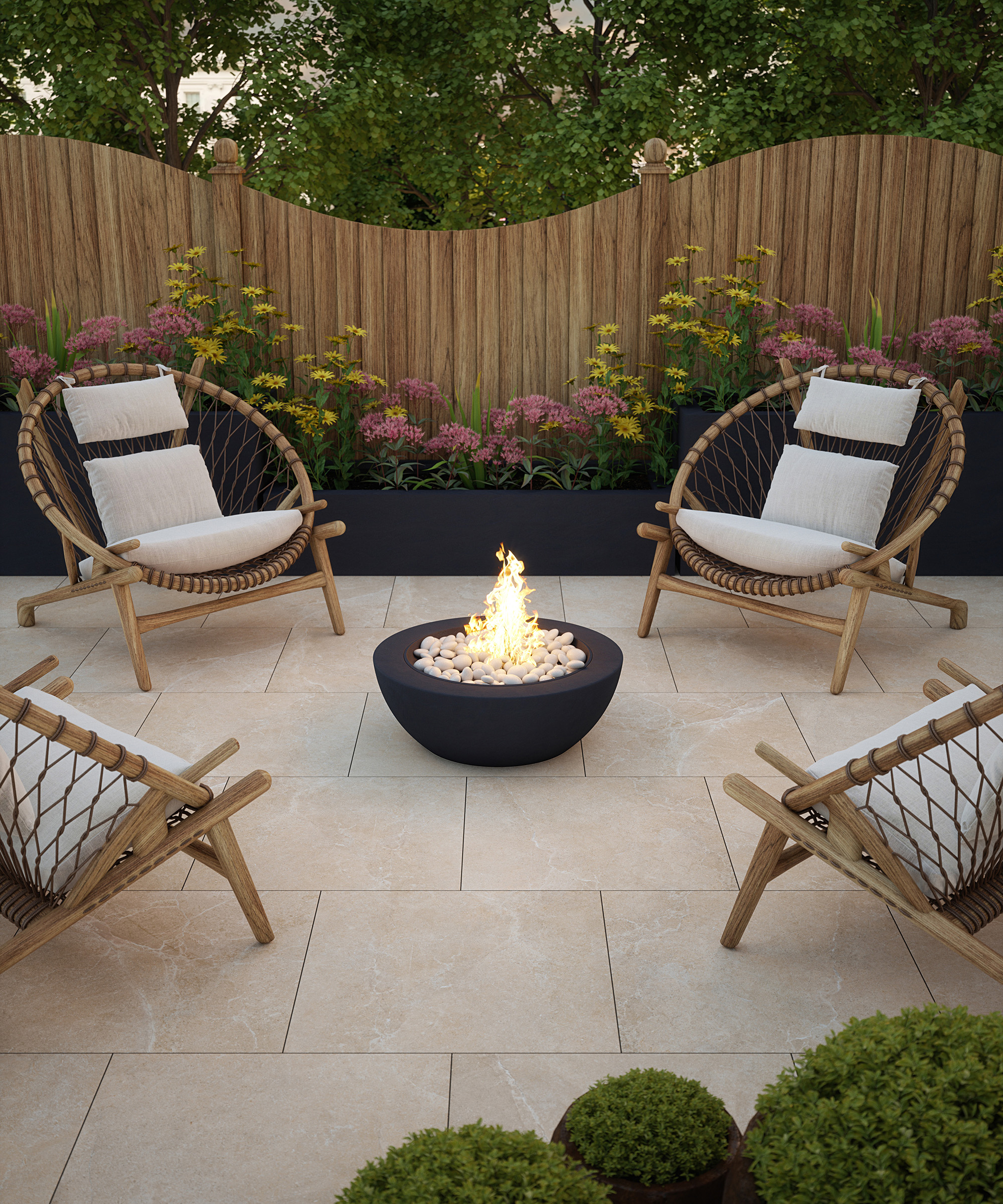
Made from white clay, fine sand and feldspar (a widely found rock forming mineral) these Clifton bone porcelain tiles at Walls and Floor are fired at very high temperatures to make them exceptionally durable and able to cope with changes in weather.
Less porous than their ceramic cousins, they resist cracking – even in frosty conditions – and prevent algae and mould from taking hold. The adaptable material can be formed in endless shapes, sizes and imprinted with different textures to accurately recreate less practical or most costly paving options.
The team at Direct Tile Warehouse are big porcelain fans. 'Spruce up a patio, garden or balcony with supersized tiles for a contemporary look all year round. Exterior large format tiles have all the same benefits on offer, making your space look larger and having higher durability. Ideal for bringing the indoors outside or creating a seamless flow from inside to out.'
Pros of porcelain tiles:
- Easy to cut and lay
- Endless choice of formats, sizes and finishes
- Perfect for inside and out
- Ideal for creating a seamless surface
- UV stable and frost resistant
- Firm and even underfoot
- Stain resistant
Cons of porcelain tiles:
- Takes time to cut, lay and dry
- Can be expensive for large areas
- Water can collect if not laid on a slight gradient
- Consider drainage if covering large area
11. Encaustic tiles
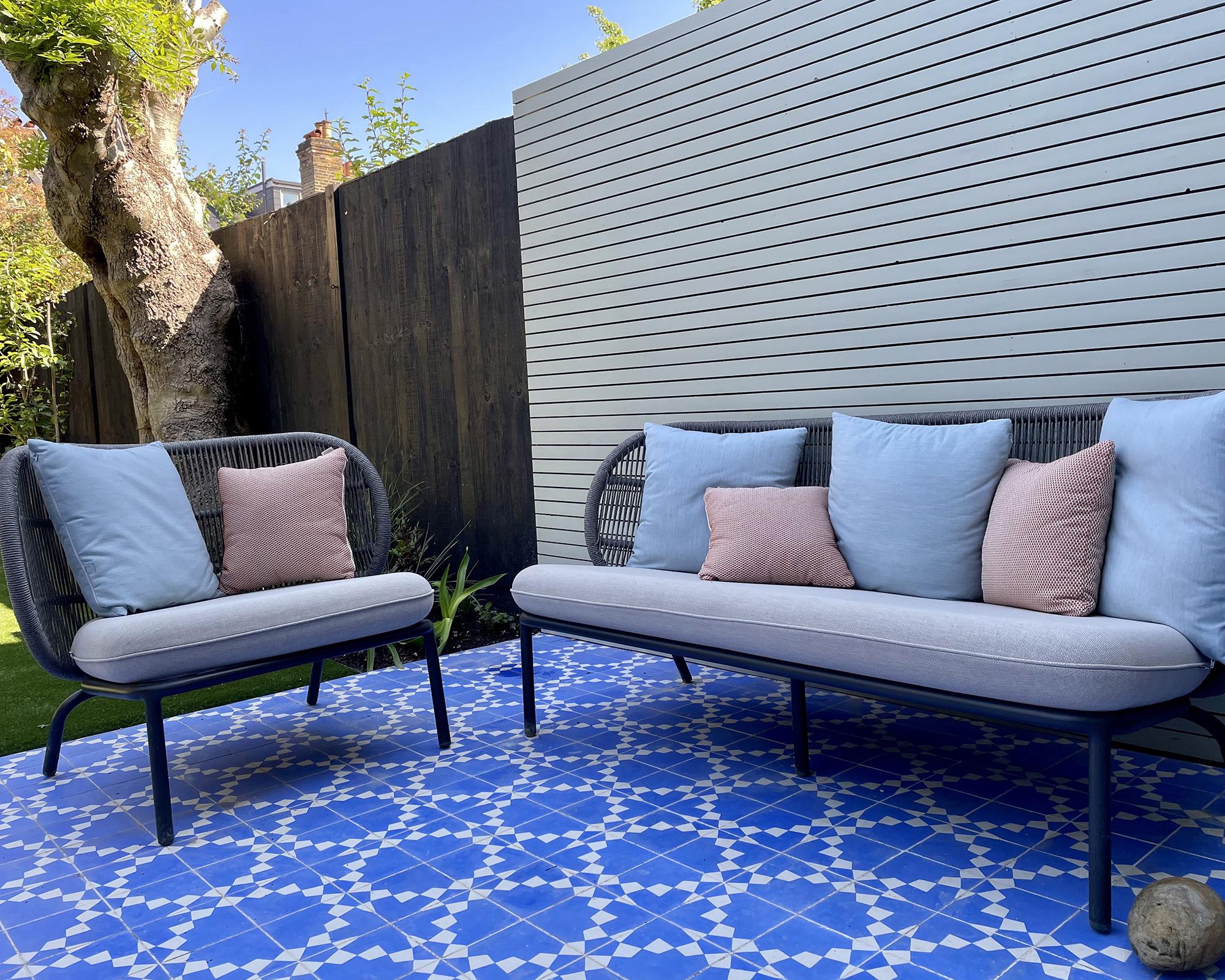
A popular choice for Mediterranean garden ideas, encaustic tiles are a brilliant way to introduce a bold splash of pattern and color to your plot.
Unlike glazed ceramic tiles, the designs on encaustic tiles also form the main part of the tile’s body. Made upside-down in a mould, traditionally two and six different colored clays and ground minerals are used in precise areas to create the pattern or image. Many contemporary designs use pigments in place of clay. Once set, the mould is removed and the tile reinforced with concrete before being soaked in water, cured and fired in a wood or coal fuelled kiln.
Grouting can play an important role in the final look of these tiles. The team at Bert & May say, 'We recommend using light colored grout on light colored tiles. If you do choose to use a dark grout, we recommend taking extra care to clean the surface of the tile throughout the grouting process. Ensure the surface of the tiles are free from dust and adhesive before you begin the grouting process.'
Pros of encaustic tiles:
- Good for adding bold color and pattern
- Pattern wears evenly as it extends into the tile
- Great for small outdoor areas or feature panels
- Creates a lively, Mediterranean feel
Cons of encaustic tiles:
- Needs cutting and careful grouting
- Not as tough and weather resistant as other options
- Can be expensive for large areas
- Small in scale, they can look fussy and overwhelming
12. Terracotta
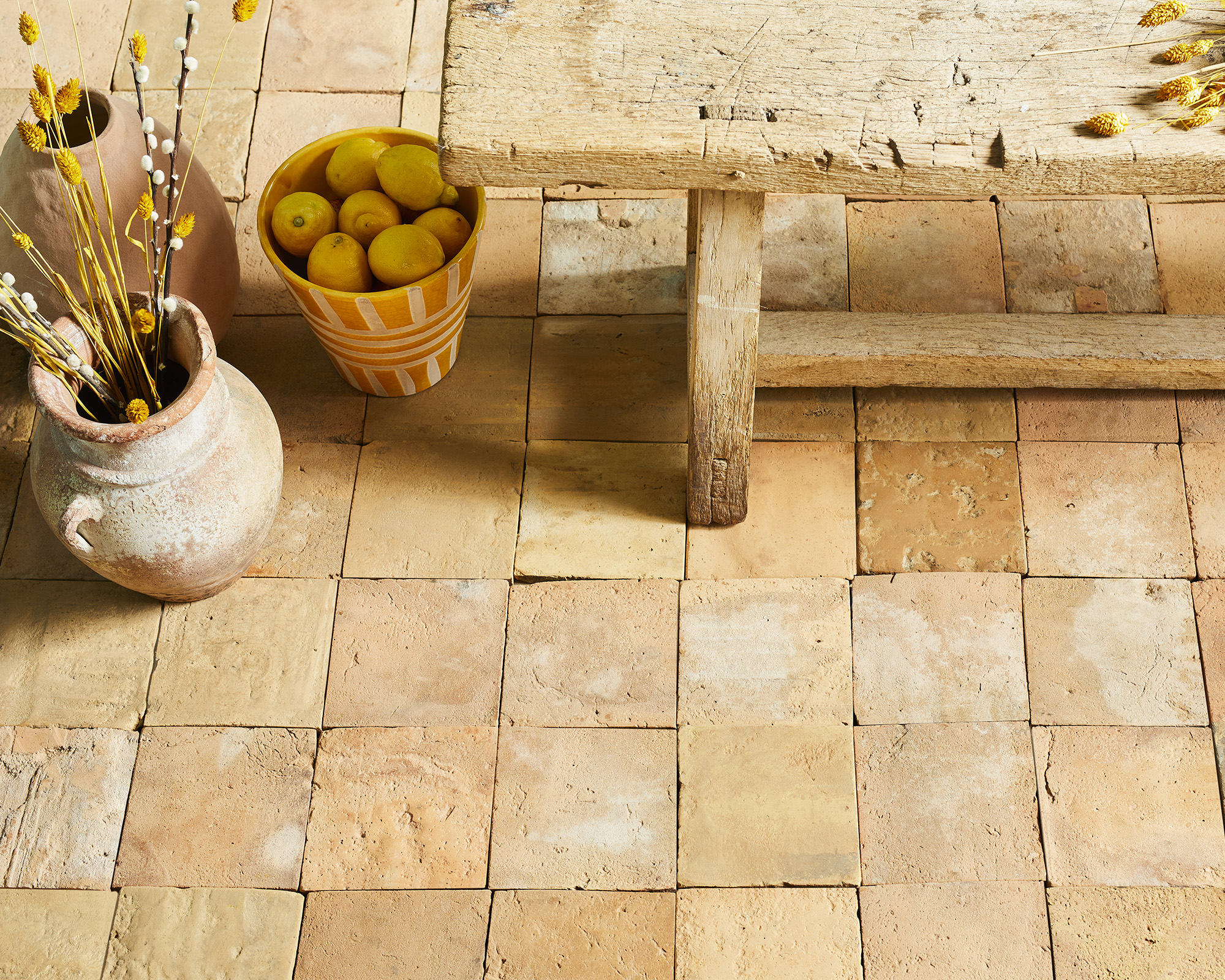
Made from 100% clay and the staple option for paving ideas in the Mediterranean, these rich red orange tiles instantly conjure up warm, sunny vibes and look gorgeous inside and out. Many of these tiles are suitable for use outside in climates similar to the UK, but this does depend on the density of the clay used and the firing temperature. The material retains heat, so can feel warm and smooth underfoot.
Pros of terracotta paving:
- Rich warm tones
- Subtle variation in color and surface adds character
- Many tile shapes available enabling a wide range of patterns
- Good slip rating
- Great for rustic style
Cons of terracotta paving:
- Porous material so can crack
- Only some tiles are frost proof
- Uneven finish and surface
- Can scratch and stain
- Can take time to lay
- Smaller in size
13. Brick pavers
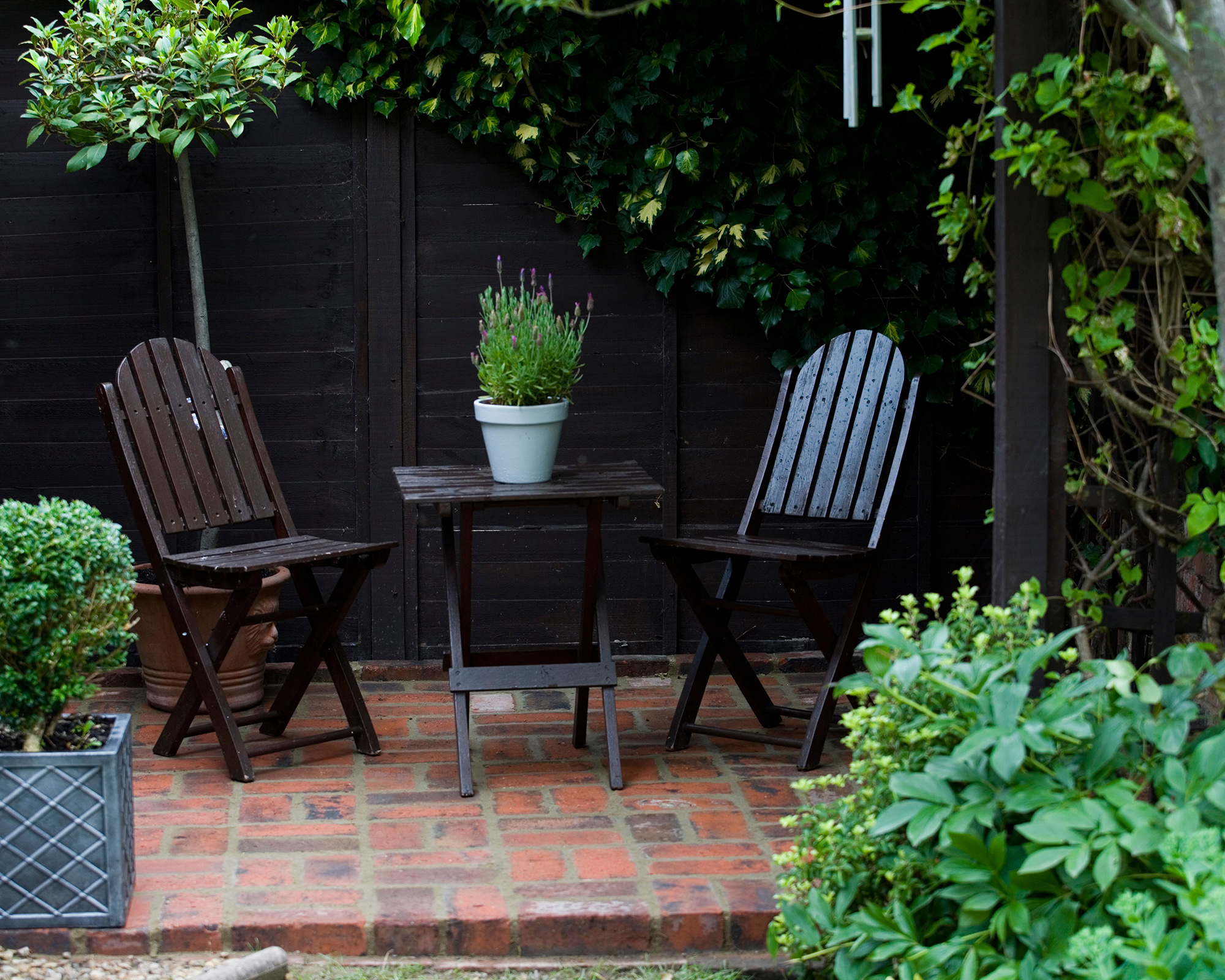
Brick or clay blocks always lend a timeless charm to any patio. Their warm earthy tones create a homely and welcoming feel and made from natural clay and sand they are a sound choice for eco landscaping ideas. If laid well, they form a long-lasting and durable surface, that will improve with time and wear. Experiment with different laying patterns for added interest too. Known as ‘bonds’ these vary from simple brick laying style to intricate herringbone and basketweave.
Brick pavers vary in color from rich orange-red to pale creams and urban greys. Jo Roberts, Landscape Category Manager, Wienerberger says, 'Something as simple as paying attention to your exterior flooring can be a subtle change to make a big impression. Our beautiful clay pavers create unique patios and winding walkways that life the overall appearance of your garden and create a real wow factor.'
Pros of using brick pavers:
- Frost resistant
- Eco friendly product
- Can be used to create intricate designs
- Choice of ‘bonds’ or laying patterns
- Creates a long-lasting, firm, level surface
- Many different shades, colors and finishes
- Easy to sweep and wash clean
Cons of using brick pavers:
- Ground needs thorough preparation and levelling
- Can be tricky to lay in small or irregularly shaped areas
- Slow to lay – especially when bricks need cutting
- Joins can need topping up with sand periodically
14. Timber decking

There’s a vast range of timber decking ideas to choose from, and which one you go for really depends on your budget and style preference. Treated softwood boards are readily available and a popular DIY option but they do need careful finishing and regular care to keep them looking their best. Many professionals favour hardwood and cedar timber for a rich, high-end result.
Nigel Gomme, landscape designer at Cityscapers often uses smooth planed Yellow Balau hardwood decking. 'Aesthetically it is a beautiful material - tough, stable and resistant to weather and very easy to maintain - an annual rub down with decking oil is all it takes to keep it looking pristine'
Pros of using timber decking:
- Rich tones and natural texture and markings
- Contemporary finish
- Level and firm surface ideal for furniture
- Warm and smooth underfoot
- Wide price range to choose from
- Hardwoods are long-lasting if well maintained
- Easy to sweep
Cons of using timber decking:
- Deckboards need a sturdy level base or frame
- Visible joins and fixings
- Requires annual scrub, wash and refinish
- Can require staining and resealing to protect and retain finish
15. Composite decking

Low maintenance, fade proof and resistant to mildew and algae, composite decking creates a smart surface that is smooth and warm underfoot. Made from blend of wood fibres, high-density polyethelene and bonding agents, it’s a tough, hardwearing, engineered board that will last up to 25 years so is a great option if you're a fan of low maintenance garden ideas. Pretty easy to install, the design possibilities are infinite, choose from smooth and pronounced-grain planks and tiles in a variety of colored and timber shades.
Pros of using composite decking:
- Choice of textured finishes and colors
- Hidden fixings for uninterrupted finish
- Easy to sweep, scrub and wash clean
- UV stable so won’t fade or deteriorate
- Simple to cut
- Smooth or reeded finish
Cons of using composite decking:
- Requires a firm and level base or sub frame
- Boards can appear artificially uniform
- Some cheaper products have a plastic feel
What is the cheapest material for a patio?
Bark mulch chippings are by far the most economical patio material. Large amounts can be bought at a time and not only is the material itself the cheapest but it's also a brilliant option if you're searching for DIY patio ideas. It's so easy to work with it's unlikely you will need to hire a contractor to lay it for you.

What is the most durable material for a patio?
Granite stone paving will last for decades. It is extremely hard wearing even in the most extreme conditions. Given its anti slip properties it ideal for cold and wet climates. It is one of the least porous natural stones which means it is less likely to develop algae and mould.
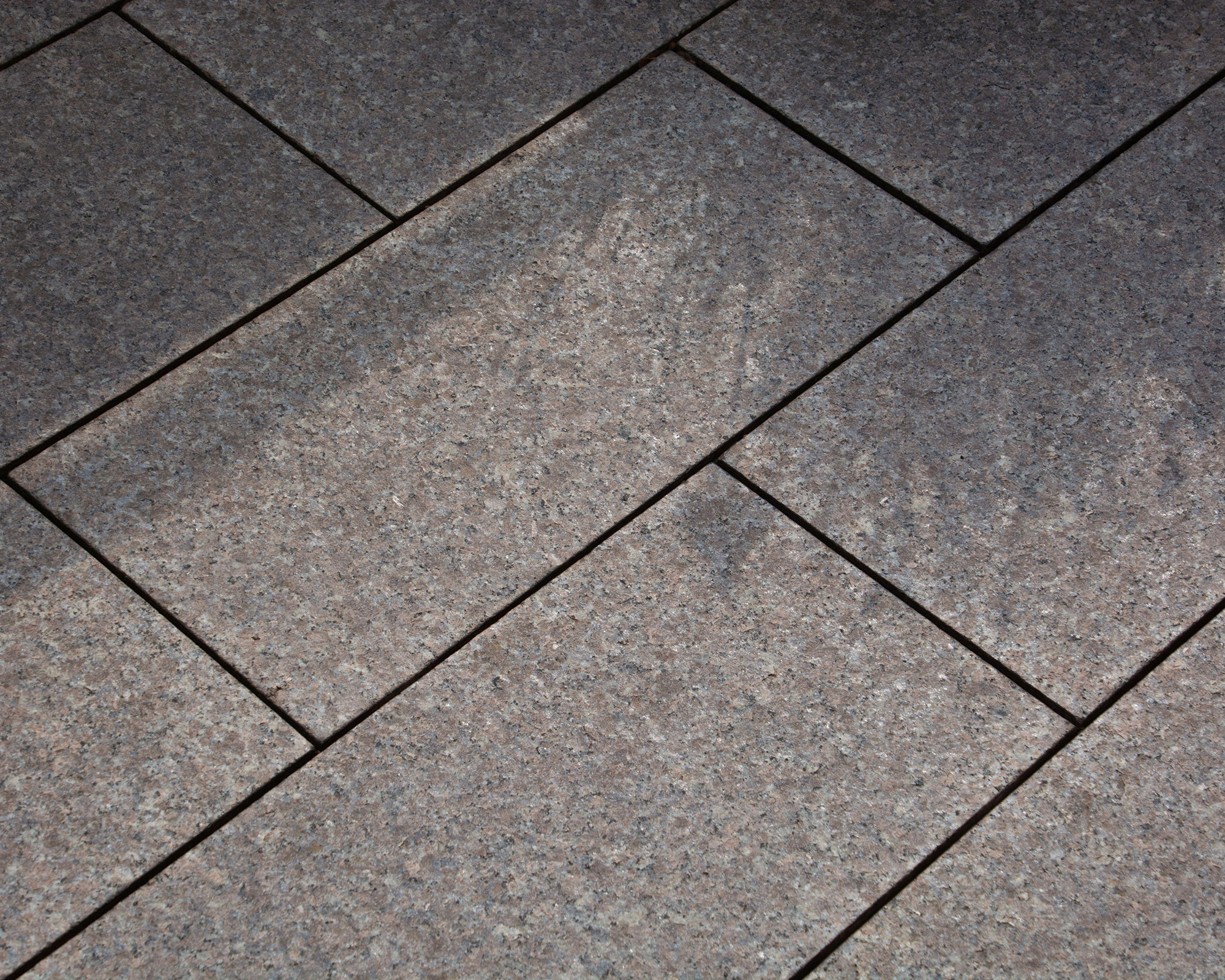
What is the best material to use to make a patio?
In terms of easy care, composite decking and porcelain tiles perform exceptionally well in most climates, needing little more than the occasional sweep and power wash.
For a contemporary look that will work with modern garden ideas, go for durable and relatively inexpensive concrete.
Go for decorative aggregates if you're inexperienced at laying patio materials or have an awkward shape to cover.
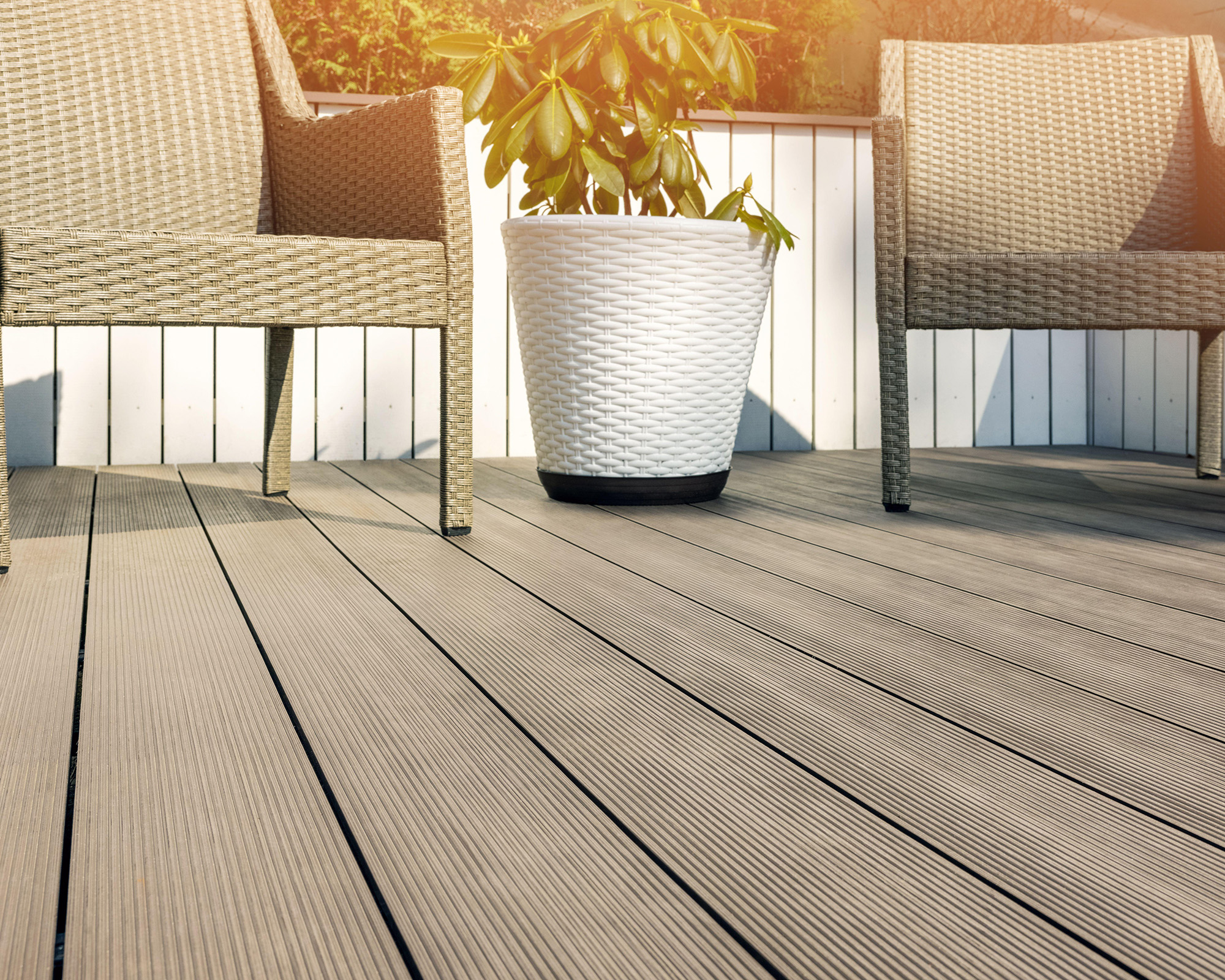

Jill puts her love of plants and all things garden related down to the hours spent pottering around with her Nan and Grandad when she was little. Today she is lucky enough to have a garden of her own in Surrey, England, and spends much of her time writing about them too.
